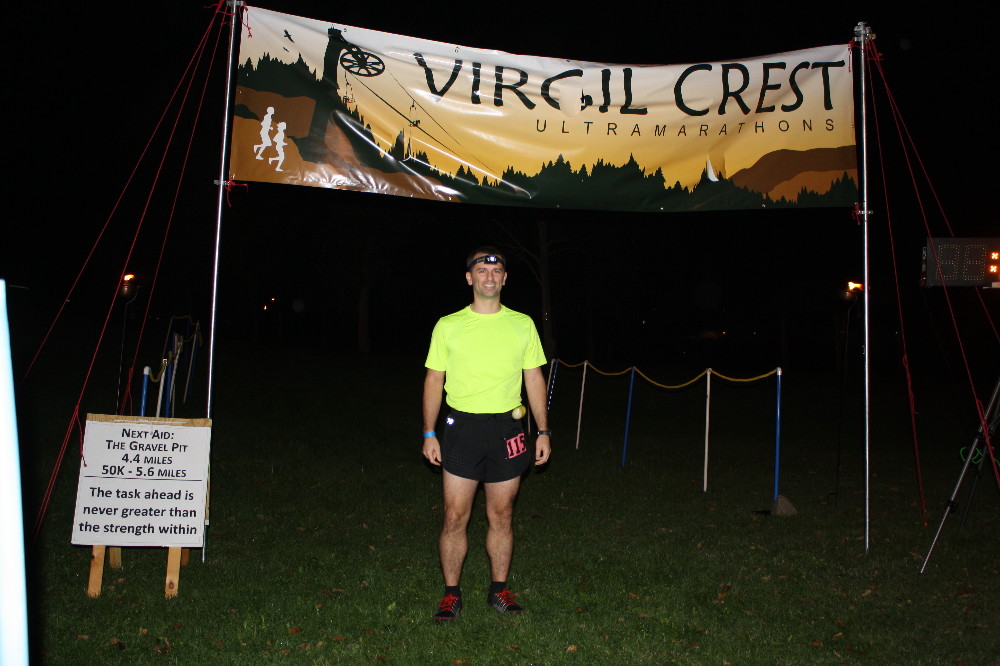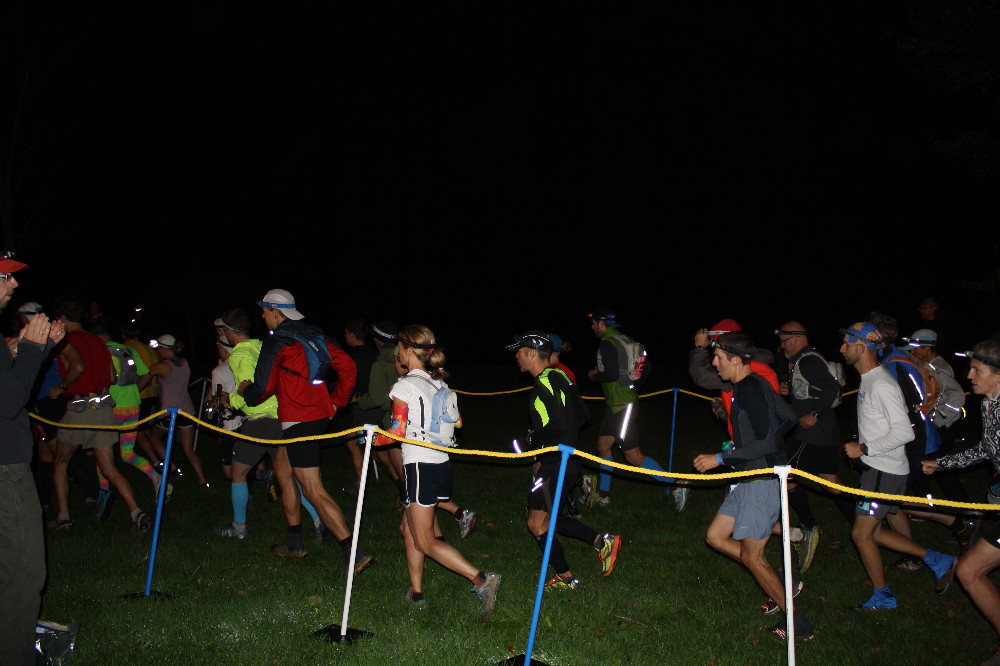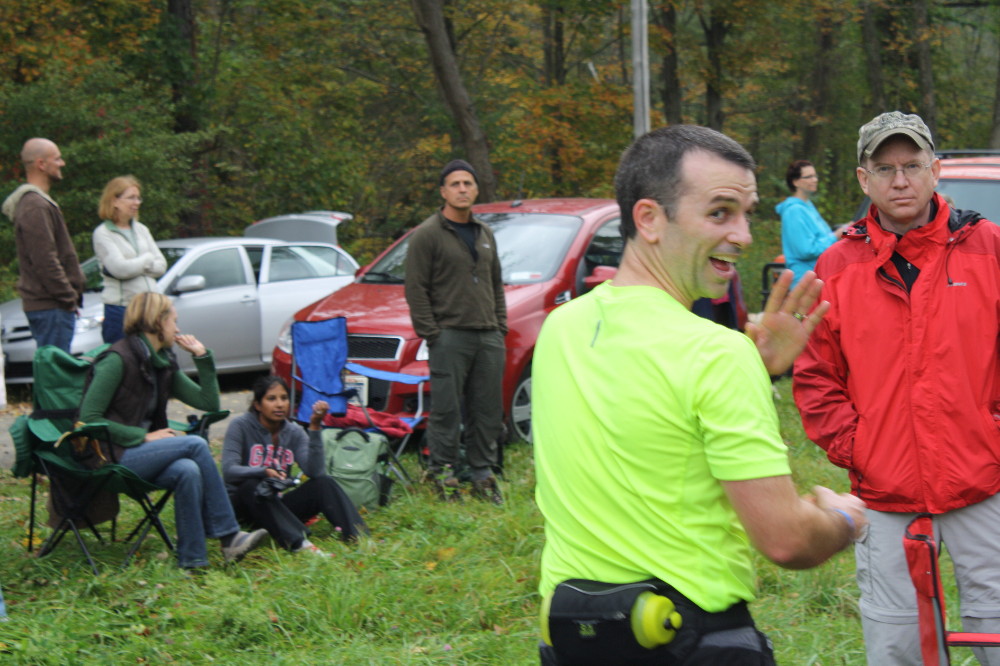 |
| At mile 0.0, before the 6:00am start |
Leading up to the 2012 edition of the Virgil Crest ultramarathon, I remained optimistic that my ankle was healing and that it’d be up to the rigors of the race. But despite putting on a brave, happy face publicly, I’d quietly been harboring doubts. My ankle had been through ups and downs in previous weeks, and although it felt better than it had, all week there was constant, lingering pain. It was mild, but with every footstep, it was there. And if my ankle hurt ever so slightly simply walking on flat paths to and from my office, how would it hold up against 50 miles of trails through rough, mountainous terrain?
As planned, we drove from the Hudson Valley to the Finger Lakes on Thursday night. On Friday I picked up my race bib—#115—and prepped my gear, hydration, and nutrition for the race. I kept it pretty simple. In the end, my gluten-free race hydration and nutrition looked liked this:
- First Endurance Electrolyte Fuel System (hydration)
- First Endurance EFS Liquid Shot (nutrition)
- First Endurance Ultragen (both)
- Cara cara navel oranges
- Bananas
- M&Ms chocolate
- Honey Stinger organic energy chews
- Luna gluten-free protein bars
- Salted potato chips
- Fanta orange soda
I snacked on handfuls of the “real” food in aid stations, swapped out my empty bottle and gel flask for fresh ones from Kelli to carry with me while running.
Ultrarunning grows more popular every year, and this year’s Virgil Crest was bigger than ever. Something like 170 runners gathered at the starting line for the 50- and 100-mile races, nearly 100 of them for the 50-mile version, including me.
- Run conservatively: I needed to wait and see how my ankle was feeling before I really started to push.
- Race beginning at the Daisy Hollow aid station: If my body was cooperating, and I wanted to really try and race this thing, then I decided that I’d start to race at the turnaround of the out-and-back course, at the Daisy Hollow aid station, mile 25.1.
- Negative split the course: In order to make sure I didn’t go out too hard too early, I focused on trying to negative split the course, which means running the second half faster than the first half.
- If all systems were go, aim to reach Daisy Hollow in 5 hours: If I reached Daisy Hollow in 5 hours, and I negative split the course, I’d succeed in going sub-10 hours for the first time. (Based on previous years’ results, I’d also succeed in breaking back into the top ten with a time like that…)
 |
| And they’re off! |
Despite recent rains, the trails were in pretty good shape, especially compared to last year’s mud-and-water fest. Although I was focused on running my own conservative race at a comfortable pace—at least to start—I soon found that my body (though not necessarily my ankle) was feeling pretty good, even though I hadn’t trained in a month. In fact, as 170 of us set off into the darkness, I found myself near the front of the pack, with a long string of shining headlamps strung out along the lakeshore behind me at Hope Lake park.
I was running what felt like a very reserved pace, yet came through the Gravel Pit aid station (#1, mile 4.6 or so) somewhere in the top 5 to 10 of the 50-mile race. At aid station #2 (mile 9.5 or so), I remained somewhere in the top 5 or 10. I was averaging 10- to 11-minute miles, and it felt very comfortable. Keeping a pace like that would easily allow me to break 10 hours. Plus, I’d spent portions of those segments running with the guy who eventually took 2nd place in the 100-mile race and another guy who finished in the top 10 of the 50-mile race. I was in good company.
But there was a problem. Somewhere around mile 7 or 8, my ankle flared up. I can’t say that I stepped “wrong.” I simply stepped one of the myriad ways you’re forced to step while trail running, and in a flash, a zing of pain returned. I tried to write it off as a fluke, but in the back of my mind I worried what it meant for the remainder of the race. I didn’t have to wait long to find out. The pain returned … and then it stayed.
By the time I reached Kelli at aid station #2, every footstep hurt. The next section of the course—about 4.5 miles long—was the “dreaded” alpine loop, which climbed the Greek Peak ski area twice. This year—probably thanks to my intense hill training in the Hudson Highlands—the alpine loop felt surprisingly benign. In fact, in spite of my ankle, the whole race was seeming easier to me than in previous years. It’s easy to say such a thing only 10 or 15 miles into a 50-miler, but three years of experience with this particular race gave me something of a veteran’s perspective. I knew what was coming. I knew which hills to power hike, and when to run. And this year simply felt different … sections of the course that in an earlier year felt “long” or “challenging” this year passed quickly and with comparatively less effort. It was confirmation that I am perhaps, as I’ve suspected, in the best shape of my life.
This made what came next all the more difficult to swallow.
 |
| Leaving Lift House 5 aid station, en route to Rock Pile at mile 20 |
When I reached Kelli again at the end of the Alpine Loop (just shy of mile 15 or so), she could tell that something was off. I told her what was going on. The sharp pain in my ankle had returned, and it wasn’t going away. In fact, it was getting worse with every mile. Downhills were the toughest, actually, which I had to run very gingerly, my right leg doing most of the effort. Uneven ground—any place with lots of roots or rocks—caused an acute sting of pain deep in the ankle. I questioned whether this thing was gonna happen. But I wasn’t ready to drop. Not yet. I wanted to at least make it to Rock Pile (aid station #4) at mile 20 and see how things felt.
I put on my smiley face (see photo above) and set off, hoping for a small miracle, but not expecting one.
The next miles were tough on my ankle. Numerous times I winced from the pain. I could tell that I was subconsciously favoring the foot. Sometime before I reached the Rock Pile, I made the decision to drop. Kelli was there waiting on a dirt road 1/3 of a mile from the aid station. I told her what was up. We had a quick conversation during which we discussed the merits of dropping versus forging on.
There’s a canon of literature and race reports of ultra runners who’ve persevered and finished a race despite some pretty incredible injuries. On this day, I wasn’t prepared to add my name to that list. This wasn’t a matter of testing myself against a distance I didn’t know if I could finish or not. I’d finished my share of 50-mile races before. This wasn’t a case of testing myself against a new course. I’d finished two previous Virgil Crests before. As Kelli and I agreed, this was a matter of either a) pushing on now and potentially doing damage to my ankle, thus ending my season early, or b) pulling the plug now, in the hopes of rehabilitating my ankle in time for the Bimbler’s Bluff ultra in Connecticut one month away at the end of October.
Kelli offered to go the Rock Pile to inform them I was dropping, but I wanted to give them the news personally. So we walked slowly together along the trail. It was a funny feeling, passing spectators, crew, and race volunteers going to and from that aid station. They’d see my bib number, and quite reasonably assuming I was one of the racers, offered hearty words of encouragement. I simply smiled and said “thank you,” not wanting to explain to each one of them that I was only walking up that hill to withdraw from the race.
At the Rock Pile, I bumped into race director Ian Golden, who I’ve now known for several years. When he asked me how my race was going, I told him I was dropping; that my ankle was done. Paraphrasing, he said something like, “You know, you have enough time left before the cutoff to pretty much walk the rest of the race and finish.” I did some quick mental math. He was right. I’d run the first 20 miles fast enough that I still had 12+ hours to cover the remaining 30 miles. That’s a pace of 2.5 miles per hour. I could certainly walk that fast.
In the end, I dropped, not wanting to put those extra miles on an ankle that was already kaput. It was a crushing decision, knowing what my true potential was for this race, but that an injury prevented it from coming to be. I never actually cried, but there were times when tears weren’t far behind my eyes.
That was all one week ago. I can’t believe that such a small amount of time has elapsed since the race. It already feels like an eternity has passed.
Meanwhile, I don’t have many answers for my ankle. I saw my orthopedist again. This time he agreed with me that the problem isn’t tendons or ligaments, but more likely bones and nerves. An MRI later this week showed that my ankle pretty much looks normal, which is puzzling. I feel a bit like the undiagnosed celiac explaining symptoms to a conventional doctor and searching for an answer and a diagnosis, but not getting anywhere. I have pain in my ankle that is real, but so far they can’t say why.
I’ve now entered into what feels like a cycle of pain and recovery. I give the ankle a week or more of solid rest, during which it improves greatly but is never fully pain-free. A doctor clears me for all activity, as my pain permits. The next weekend, I do a test run and the ankle blows up, which restarts the cycle. This is again where I find myself. My ankle feels pretty good as I write this, but it isn’t pain-free, and I can feel—yet again—that certain motions bring the pain out. But I’ve once again been cleared for activity, as pain permits. If the pain returns, the orthopedist wants to do injections into the ankle. I’m not necessarily opposed to injections, but for what? Do we know what we’re treating? What’s the cause of this phantom pain I experience when running?
Answers, thus far, have been elusive. But if I learned anything during my two years of being really sick, leading up to my going gluten-free in early 2007, it’s this: medicine can be complicated. Sometimes in hindsight the answers seem clear and obvious, but it’s an imperfect combination of art and science. The ankle is a complicated joint, and lots of things can go wrong. We’ve potentially ruled out some things, and not others. Hopefully, though, there’s an answer waiting. (Alternatively, I wouldn’t mind not having an answer as long as the pain goes away and I can return to training…)
To quote the Dixie Chicks, I’m ready, ready, ready to run…
–Pete
I know it must have been frustrating to have to drop, but I am sure it was a good decision.
We have dealt with many of those hard to detect medical issues. Eventually it will present itself.